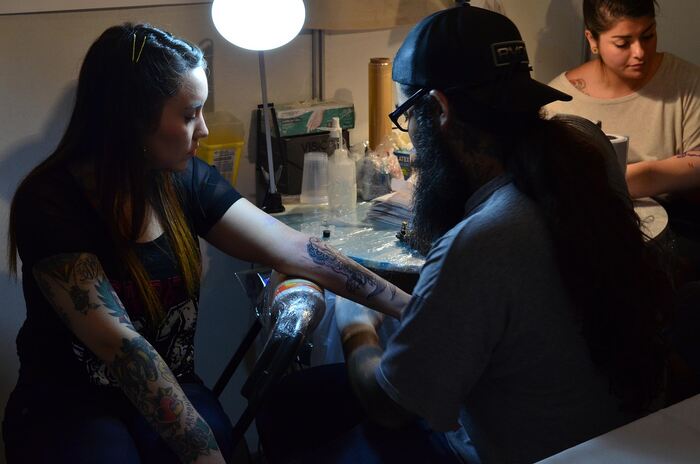Getting a tattoo or a body piercing is an exciting form of self-expression, but the process doesn’t end once the needle stops. Healing is a crucial stage that determines the final appearance and comfort of the modification. While tattoos and piercings involve breaking the skin, their healing timelines, care routines, and potential complications differ. Understanding what to expect after each procedure helps individuals care for their bodies correctly and ensures the results align with their expectations. Clear knowledge of the healing process makes the experience more manageable and reduces the likelihood of problems during recovery.
How do tattoo and piercing healing processes differ?
1. The Initial Healing Phase of Tattoos
A freshly done tattoo is essentially an open wound; the first few days are about minimizing irritation and protecting the area. Most people notice redness, swelling, and a warm sensation near the tattoo site during the first 24 to 48 hours. This is a normal immune response to trauma, and it typically subsides with proper care. Tattoo artists often recommend covering the area initially, followed by gentle washing and applying a fragrance-free healing ointment. Over the next week, the tattoo begins to scab lightly and may flake as dead skin sheds. It’s important not to pick at scabs or scratch the area, as doing so can cause patchy healing and ink loss. The colors may appear dull during this temporary stage, which improves once the skin regenerates.
2. Piercing Healing Timelines and Early Reactions
Piercings, unlike tattoos, involve inserting jewelry into a puncture opening that the body must accept as it heals around the foreign object. The healing timeline varies widely depending on the location of the piercing. Earlobes typically heal in a few weeks, while cartilage or surface piercings may take several months. Swelling, redness, and discharge of clear or slightly yellow fluid are common initially. For those getting a body piercing in Austin, it’s essential to recognize the difference between routine healing and signs of infection, particularly given the city’s warm climate, which may increase the likelihood of bacterial exposure. Daily saline soaks, avoiding touching with unwashed hands, and sleeping on the opposite side are key habits that support healthy healing. The jewelry should remain in place throughout the healing period, even if it appears to be healed on the surface.
3. Mid-Healing Sensations and Challenges
Itching often becomes the primary discomfort around the second week of tattoo healing. This is a sign that new skin is forming beneath the surface, and while tempting, scratching should be strictly avoided. Applying a thin layer of unscented lotion can ease the itch and prevent skin cracking. Tattoos continue to shed light flakes during this time, and the appearance of the ink may change slightly as layers of skin heal. With piercings, the mid-healing stage often involves tightness around the jewelry and a hardened bump of tissue near the opening. This is not necessarily a sign of infection; it can indicate the body’s natural response to healing around a foreign object. However, any dramatic changes in pain, redness, or discharge should be monitored carefully, and professional advice should be sought if the symptoms worsen or persist.
4. Long-Term Recovery and Maintenance
After the visible signs of healing have faded, tattoos and piercings enter a long-term maintenance phase. For tattoos, this means protecting the ink from direct sun exposure, which can fade colors and cause early aging of the skin. Moisturizing regularly also keeps the tattoo looking sharp and reduces the chance of dry, irritated skin in the future. Most tattoos are functionally healed in three to four weeks, though deeper layers of skin may take longer to regenerate fully. Conversely, piercings may look healed on the surface but still require internal healing for many more months. Continued saline soaks, avoidance of physical trauma, and keeping the jewelry intact are essential. Piercings that are prematurely removed can close up quickly, especially if the healing is incomplete. Listening to the body and being patient with the healing process is essential for long-term success.
5. Differences in Aftercare Products and Risks
The types of aftercare products used for tattoos and piercings differ due to their healing environments. Tattoo care often involves mild soap, fragrance-free moisturizer, and breathable dressings during the first few days. Avoiding petroleum-based products that can clog pores and trap bacteria is essential. For piercings, saline solution is preferred, and alcohol-based cleansers should be avoided as they can dry out and irritate the skin. One of the main risks with tattoo healing is improper hygiene, which can lead to infection or ink loss. With piercings, risks include migration, rejection, or keloid formation, particularly in cartilage or surface areas. Recognizing early signs of complications and seeking advice promptly can prevent these issues from escalating. Clear communication with the artist or piercer also supports a smooth recovery, as they can guide the client through unexpected developments.
Caring for Art and Healing with Intention
Understanding the healing differences between tattoos and piercings allows individuals to approach body modification with greater awareness and care. Tattoos require moisture and protection from friction and sunlight, while piercings demand consistent cleaning, patience, and minimal interference. Each process has its timeline and discomforts, but with proper aftercare, both can heal cleanly and showcase the wearer’s individuality. As the body responds to the changes introduced by ink or jewelry, attentiveness and hygiene play vital roles. By respecting these processes and investing in their care, clients ensure that their modifications heal well and remain vibrant and healthy for years to come.
Read Also: How Safe Is Tattoo Removal? Side Effects & Risks Explained


